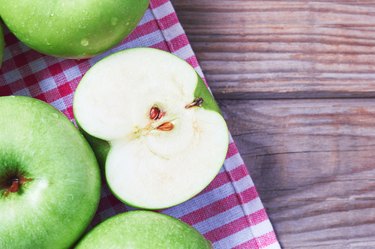
Granny Smith apples have a unique tart flavor that you either love or don't quite care for. Here's what you need to know about the Granny Smith apple nutrition profile, in terms of how many calories and carbs are in a Granny Smith apple and the health benefits it has to offer.
Read more: Calories in One Green Apple
Video of the Day
Video of the Day
The Origin of Granny Smiths
Granny Smith apples originated in Australia, in a suburb of Sydney, in 1868, according to the Worcester Tree Initiative. The apples are named after Maria Ann "Granny" Smith, the woman who first grew them. They are the offspring of a French Crab apple tree and whatever tree happened to pollinate it, resulting in this unique species of apple.
Interestingly, you can't plant a seed from a Granny Smith apple or a French Crab apple and expect to grow the same type of tree. This is because the new tree won't be a clone of its mother tree's genes; it combines the genes of two parent trees and the result is a different type of tree altogether.
If you want to grow a Granny Smith apple tree, you need to grow it from the cutting of an existing Granny Smith apple tree. The Worcester Tree Initiative explains that all the Granny Smith apple trees have therefore been grown from cuttings that trace their history back to the original tree.
Read more: Apple Seed Benefits
Granny Smith Apple Nutrition
The USDA lists Granny Smith apples' nutrition information. A medium-sized Granny Smith apple has 96.9 calories. These calories are primarily from carbs, since these apples do not contain much protein or fat. There are 22.7 grams of carbs in a Granny Smith apple.
The carbs in Granny Smith apples are from natural sugars as well as fiber; 16 grams of the total carbohydrate content are from sugars and 4.68 grams are from fiber. The Wyoming Department of Education notes that the soluble fiber in Granny Smith apples provides health benefits like lower cholesterol levels, better weight management and blood sugar regulation.
In terms of micronutrients, Granny Smith apples are a good source of potassium and vitamin A, and they offer small amounts of other minerals like calcium, magnesium and phosphorus, per the USDA. According to a study published in the journal Food & Function in June 2018, Granny Smith apples also contain a number of phenolic compounds that reduce oxidative stress and prevent inflammation.
According to USApple, Granny Smiths are all-purpose apples that can be eaten as is or cooked into pies and sauces. If you're snacking on an apple, the Harvard T.H. Chan School of Public Health recommends eating whole, fresh fruits with the peel on to help you make the most of your Granny Smith apple's health benefits.
Per the Harvard T.H. Chan School, peeling apples causes you to lose out on a lot of their fiber and flavonoids and drying them can eliminate important nutrients. Dried apples may also have added sugar. Clear apple juice has been filtered and pasteurized, which again removes fiber and nutrition.
- USApple: “Popular Varieties”
- Worcester Tree Initiative: “Granny Smith Apple”
- USDA: “Apples, Raw, Granny Smith, With Skin”
- Wyoming Department of Education: “Informational Sheets: Baby Granny Smith Apples”
- Food & Function: “Granny Smith Apple Procyanidin Extract Upregulates Tight Junction Protein Expression and Modulates Oxidative Stress and Inflammation in Lipopolysaccharide-Induced Caco-2 Cells”
- Harvard T.H. Chan School of Public Health: “Apples”